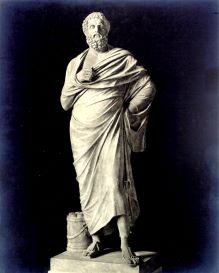 Original statue of Sophocles, Lateran Museum Rome
Original statue of Sophocles, Lateran Museum Rome
The Greek playwright Sophocles was one of the three great classical tragedians alongside Aeschylus and Euripides.
Born around 496 BCE in the Attic community of Kolonos near Athens, died 406 BCE in Athens, Sophocles was the son of the rich arms manufacturer Sophillos.
In his dramas Sophokles increased the number of actors from two to three, the number of choir singers from 12 to 15 and mostly renounced the trilogical composition. Of 123 dramas, seven are complete, of the others only titles and fragments, of his satyr plays about 400 verses, of epigrams and elegies only remains.
The surviving works are: Antigone, King Oedipus, Oedipus on Colonos, Aias, The Traquinesses, Electra and Philoctetes.
Sophocles won 24 competitions at the Dionysias, the dramaturgy festival held in honour of the god Dionysus.
He formed his characters from the way they acted as defined in the myth of the epic tradition, which he psychologically motivated by their character. By not knowing the divine truth, his heroes, often to an unjustifiably high degree, are torn into tragic suffering and death, often leading them into hubris (delusion) into the tragic situation.
Sophocles was already considered a classic in antiquity, read and passed down as a school author. From the 16th century onwards, the fabrics designed by Sophocles, especially Antigone, Elektra and Oidipus, underwent a variety of musical arrangements and are also effective on the modern stage.
Roman copy of a statue erected around 330 BC in the Dionysostheater in Athens, Terracina found in 1839, height 204 cm, marble. Exhibit of the Vatican Lateran Museum.













